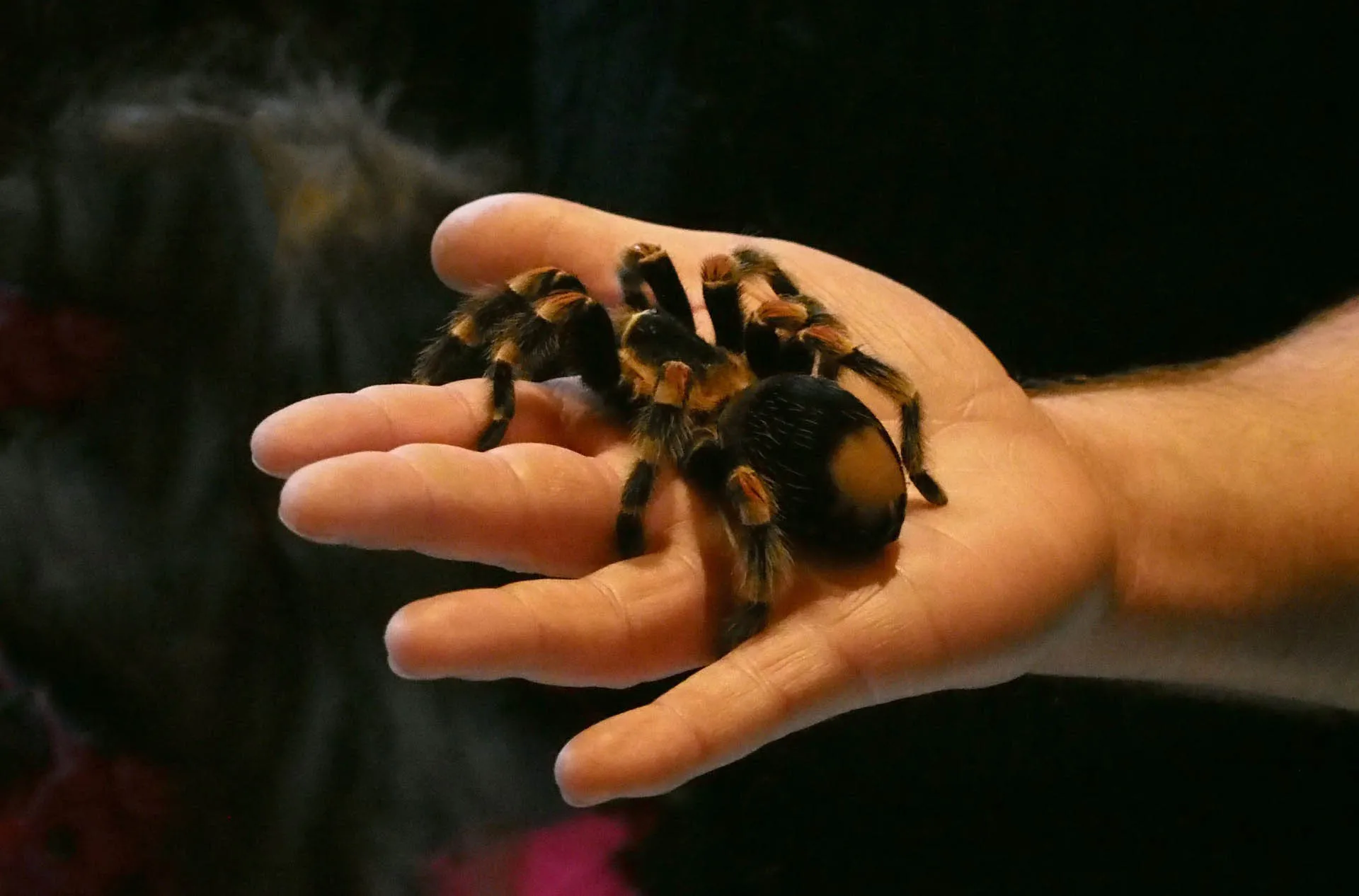Why Hold a Tarantula
The allure of holding a tarantula often stems from a fascination with these impressive arachnids. Many people are drawn to their unique appearance, size, and the opportunity to interact with a creature so different from the typical household pet. Holding a tarantula can be a way to connect with nature, experience the thrill of the exotic, and satisfy a curiosity about these often-misunderstood animals. It is important to note that while many find the idea exciting, it is essential to prioritize the safety and well-being of both the handler and the tarantula. A responsible approach involves understanding the potential risks and taking necessary precautions to ensure a positive experience for everyone involved. Considering the tarantula’s perspective is crucial; they are not naturally inclined to be handled and may experience significant stress if not approached with care.
What Are the Risks of Holding a Tarantula
Holding a tarantula, while potentially rewarding, carries several risks that prospective handlers must consider. The primary concern is the potential for a bite. Although tarantula bites are rarely life-threatening to humans, they can be painful and cause localized symptoms such as swelling, redness, and itching. The severity of the reaction can vary depending on the species of tarantula and the individual’s sensitivity. Aside from bites, tarantulas also possess urticating hairs, which are tiny barbed bristles that they can flick off their abdomen as a defense mechanism. These hairs can cause significant irritation to the skin and eyes, leading to discomfort and potential allergic reactions. Furthermore, handling a tarantula can be stressful for the spider, potentially causing it to become defensive or even drop its abdomen, which can be fatal. It is important to weigh these risks against the desire to handle the tarantula and make informed decisions based on the spider’s welfare.
Tarantula Bites Understanding the Threat

Tarantula bites, while not generally considered lethal to humans, can be a cause for concern due to the potential for localized pain and reactions. The venom of a tarantula is primarily designed to subdue its prey, which typically consists of insects and small animals. The effects of a bite can vary widely based on the species of the tarantula and the individual’s sensitivity. Some people may experience only mild discomfort, while others could have more pronounced symptoms. The severity of a bite also depends on factors such as the amount of venom injected and the location of the bite. It’s essential to understand that a tarantula bite is not the same as a spider bite from a medically significant spider; the venom is less potent and designed for different purposes. Regardless, if bitten, it is crucial to clean the wound thoroughly and monitor for any signs of infection or allergic reaction. Seeking medical advice is recommended, particularly if symptoms worsen or are severe.
Venom and Its Effects
The venom of a tarantula is a complex mixture of toxins designed to immobilize and digest its prey. In humans, the effects of tarantula venom are usually localized and relatively mild. Common symptoms include pain at the bite site, redness, swelling, and itching. In some cases, there may be muscle cramps or stiffness. The intensity of these symptoms varies depending on the species and the individual’s response. For example, some tarantula species have more potent venom than others, and a person’s sensitivity to the venom also plays a role. It is important to note that severe reactions are rare, but they can occur. Should symptoms become severe or worsen rapidly, seeking medical attention is advisable. Generally, the effects of a tarantula bite subside within a few hours or days, but it is still essential to monitor the bite site for any signs of infection.
Allergic Reactions
In addition to the direct effects of the venom, there is also the potential for allergic reactions to a tarantula bite. Allergic reactions can manifest in various ways, ranging from mild skin irritation to more severe systemic responses. Symptoms of an allergic reaction may include hives, itching, swelling (especially of the face, lips, or tongue), difficulty breathing, and nausea. In rare cases, a severe allergic reaction, known as anaphylaxis, can occur and requires immediate medical attention. It is crucial for anyone who has been bitten by a tarantula to monitor themselves for any signs of an allergic reaction. If any of these symptoms appear, it is important to seek immediate medical care. Individuals with known allergies to insect bites or other allergens may be at a higher risk of experiencing an allergic reaction to a tarantula bite. Being aware of your own sensitivities and being prepared to respond appropriately is a key aspect of handling tarantulas safely.
Handling Techniques Safety First

Before considering holding a tarantula, prioritize safety by creating a secure and suitable environment. First, ensure the tarantula’s enclosure is stable and escape-proof, preventing accidental escapes during handling. Next, assess the tarantula’s temperament. Observe its behavior; if it seems agitated or defensive, holding should be avoided. Gather the necessary equipment, including a soft surface to catch the tarantula if it falls and possibly gloves to protect your hands from urticating hairs or a bite. Always wash your hands thoroughly before and after handling to prevent the spread of any potential contaminants. Consider wearing long sleeves and pants to minimize skin exposure. Ensure that you are in a quiet, well-lit area, free from distractions that could startle the tarantula. Remember, the goal is to create a safe and stress-free experience for both you and the tarantula.
Preparing Your Environment
Setting up the right environment is crucial for a safe handling experience. First, choose a well-lit room to ensure you can clearly see the tarantula and its movements. Minimize distractions, such as loud noises or sudden movements, which could startle the spider. Clear the area of potential hazards, such as sharp objects or anything the tarantula could climb on and fall from. Prepare a soft surface, like a bed or a thick blanket, in case the tarantula falls. Make sure to have a clear, unobstructed path from the enclosure to the handling area. Consider the temperature of the environment, ensuring it is comfortable for both you and the tarantula; extreme temperatures can cause stress. Always have a designated spot where the tarantula can be safely returned to its enclosure if it becomes stressed or agitated. Having everything prepared beforehand will help streamline the handling process and reduce potential risks.
Proper Handling Methods
Approach the tarantula slowly and calmly. Avoid making sudden movements or loud noises that could frighten it. Gently encourage the tarantula to walk onto your open hand or a surface like a paintbrush; avoid grabbing or forcing the spider. Support the tarantula’s body to prevent it from falling, always keeping it close to the ground to minimize the distance of a potential fall. Keep your movements slow and deliberate, allowing the tarantula to move at its own pace. Watch for signs of stress, such as the tarantula rearing up, flicking hairs, or moving rapidly. If the tarantula displays these behaviors, carefully and slowly return it to its enclosure. Avoid handling the tarantula for prolonged periods to minimize stress. After handling, thoroughly wash your hands, and be sure to inspect for any potential issues.
Best Practices for Safe Handling

Prioritize the tarantula’s well-being by starting with short handling sessions to minimize stress. Always supervise children and inexperienced handlers when they are interacting with a tarantula. Never handle a tarantula if you have any open wounds on your hands, as this could increase the risk of infection. If the tarantula exhibits defensive behavior, immediately stop handling it and return it to its enclosure. After handling, thoroughly wash your hands with soap and water, and make sure to wash any clothing that may have come into contact with the tarantula or its habitat. Regularly inspect the tarantula’s enclosure for any signs of escape, and ensure that it is always secure. By following these best practices, you can minimize the risks associated with handling and contribute to a safer, more enjoyable experience.
Tarantula Behavior and Signals
Understanding tarantula behavior is key to assessing whether handling is safe. Tarantulas communicate through their actions, and recognizing these signals can help you avoid a negative interaction. A tarantula that is relaxed and comfortable will typically move slowly and deliberately, with its legs spread out. Look for a posture that doesn’t involve raised legs or defensive positioning. Conversely, a tarantula feeling threatened might display a defensive posture, lifting its front legs and fangs in a threatening stance. It may also flick urticating hairs from its abdomen, which can cause skin irritation. Some tarantulas may also hiss or make other sounds, indicating their displeasure. Observing these cues carefully will help you determine if the tarantula is in a state of stress or aggression, allowing you to make informed decisions about handling.
Recognizing Stress and Aggression
Recognizing signs of stress and aggression is essential for safe handling. A stressed tarantula will often exhibit a defensive posture, rearing up on its hind legs and raising its front legs and fangs. It may also flick urticating hairs from its abdomen as a warning. Other signs of stress include rapid movement, excessive leg flicking, and a tendency to retreat into a corner or hide. If you notice any of these behaviors, immediately stop handling the tarantula and allow it to retreat. Aggression is not always obvious, and some tarantulas are naturally more defensive than others. Always prioritize the tarantula’s well-being and avoid handling it if you are unsure of its temperament. When in doubt, it is always best to err on the side of caution and refrain from handling.
Understanding Tarantula Temperament

The temperament of a tarantula varies significantly between species and even between individuals. Some species, such as the Chilean rose hair tarantula, are known for being relatively docile and may tolerate handling. Other species, like the OBT (Orange Bitey Thing) tarantula, are notoriously defensive and are best left undisturbed. When considering holding a tarantula, research the specific species to learn about its typical temperament. Observe the individual spider over time to get a sense of its personality and behavior. Remember that even a typically docile tarantula can become defensive if it feels threatened or stressed. Take into account that various factors can influence a tarantula’s mood, including its feeding schedule, molting cycle, and the environment it is kept in. By understanding these factors and recognizing individual behaviors, you can make informed decisions about handling.
Top 5 Facts Holding Tarantulas
- Bites are Rare, But Possible: Tarantula bites are not common but can occur, resulting in localized pain, swelling, and discomfort. Severity varies by species and individual. Always be prepared and know what to do. 2. Urticating Hairs are a Defense: Many tarantulas have urticating hairs, which can cause skin and eye irritation. Avoid touching the abdomen and wear gloves if necessary. Be aware of what to do if you get hit. 3. Stress Matters: Handling can stress tarantulas, leading to defensive behaviors. Always observe for signs of stress and provide a safe return to their enclosure if they appear unhappy. Do not handle if they are stressed. 4. Species and Individual Temperament Vary: Different species and individual tarantulas have different temperaments. Research your tarantula and understand its behavior before handling. 5. Safety First Always: Prioritize safety, both for yourself and the tarantula. Proper preparation, handling techniques, and understanding behavior are crucial for a positive experience.
